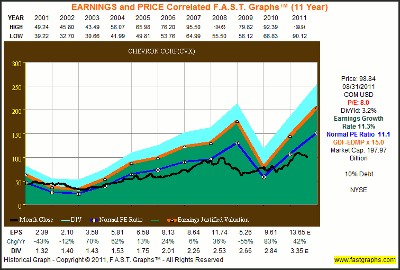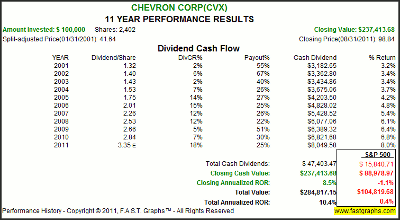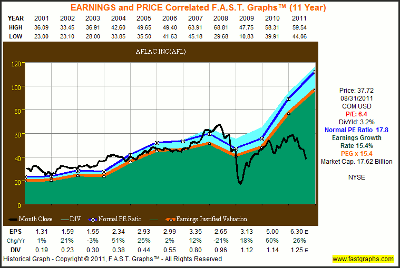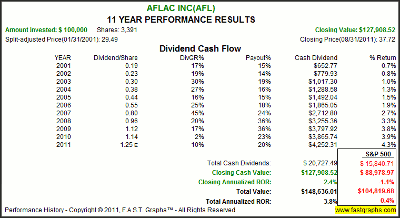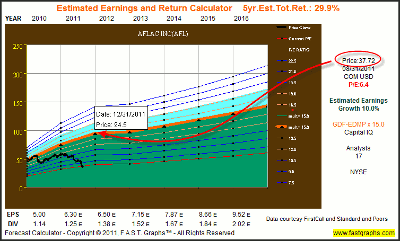Don’t invest in the stock market. Instead, invest in great businesses, writes Julie Carnevale of F.A.S.T. Graphs.
We tend to focus more on how the business is performing on an operating basis than we do on stock-price volatility. In other words, we are most interested in whether or not the company is generating growth in earnings and cash flows, and thereby increasing their intrinsic value.
Our rationale is based on the reality that any business, public or private, ultimately derives its value from the amount of cash flows and earnings it can generate for stakeholders.
Investors—true investors—buy income streams when they invest. The bigger the income stream they can buy, the bigger the value they will eventually receive.
Consequently, the faster a company is capable of growing their business, the more valuable they are to their stakeholders. To us, this is only common sense.
In this same vein, any income stream has a value greater than one. In other words, when purchasing a future stream of income, the investor is required to pay a multiple to buy it.
Therefore, even a fixed-income vehicle like a bond or CD will command a multiple based on its yield, even with no growth. For example:
- A 10% bond would be selling at a price-to-interest ratio of ten (100/10% = 10).
- An 8% bond would be selling at a price-to-interest ratio of 12.5 (100/8% = 12.5).
- And currently, the 30-year 3.55% Treasury is selling at a price-to-interest ratio of 28 (100/3.55% = 28.16)—again, even though it offers no growth of income.
Therefore, we logically conclude from the above paragraph that a growing income stream should be worth more than a fixed or non-growing income stream. Again, this is based on our principal that a bigger income stream is worth more than a smaller one.
Of course, risk would also come into play on the notion that a bird in the hand is worth more than two in the bush. However, our main point is that the actual yield that an income stream provides the investor is where its ultimate value comes from.
The following are two companies whose past, present, and future business results warrant much higher prices than the market is currently applying to them based on their earnings and cash flows. Both companies possess above-average historical operating records and both are expected to continue to grow at above-average rates in the future.
When you understand that a normal price-to-earnings ratio for an average company has been 15 over the last 150 years, the single-digit P/E ratios applied to these above-average companies immediately becomes ludicrous.
Most importantly, our contention that these stocks are undervalued is not based on esoteric statistical inferences. Our valuation model is based on factual earnings yields and fundamental strengths.
Both of these picks have very low levels of debt, and historical normal valuations that are significantly greater than what they are today. The only way these valuations would make any sense is to assume that each of these companies is perilously close to going out of business.
Yet, nothing could be farther from the truth. These companies are healthy and strong companies with bright futures and growing income streams. Consequently, we consider it a conservative assumption and a realistic forecast to state emphatically that each of these companies should command an average P/E ratio of 15 as a bare minimum.
Therefore, because they are at such low valuations, we believe the rewards from owning these companies over the next three to five years are potentially extraordinary, and the risks relatively low.
|pagebreak|Chevron Inc. (CVX)
Chevron is the world’s fourth-largest oil company based on reserves. It is financially very strong, with little debt and strong cash flow generation. The opportunity to invest in such a high-quality company at such a low valuation is rare.
Chevron has a superior track record, as compared to the S&P 500, since calendar year 2001. Also, they’ve increased their dividend every year, which caused the return to shareholders to exceed double digits at a time when the average company would have lost shareholder money.
The consensus of 15 leading analysts reporting to Zacks expects Chevron to continue to grow earnings over the next five years at 18% per annum. The red circle shows what the current stock price is and the red arrow points to what it should be if the market was pricing it at a normal PEG P/E ratio of 18.
|pagebreak|Aflac Inc. (AFL)
Aflac is the world’s largest underwriter of supplemental cancer insurance. Since Aflac generates approximately 75% of its revenues and profits in Japan, the recent catastrophe caused its stock price to fall to today’s historically low valuation.
Nevertheless, Aflac (AFL) continues to generate solid operating performance, and earlier this year dramatically reduced the risk of its portfolio. We believe the only thing truly wrong with this strong insurer is its unreasonably low stock price.
Aflac’s track record has been better than the S&P 500, even though its valuation is so low today. Note the strong dividend record, where the company raised its dividends in both the recessions of 2001 and 2008.
The consensus of 17 leading analysts reporting to Capital IQ expects Aflac to continue to grow earnings over the next five years at 10% per annum. The red circle shows what the current stock price is, and the red arrow points to what it should be if the market was pricing it at a normal P/E ratio of 15.
Read more from F.A.S.T. Graphs here…
Related Readings:

